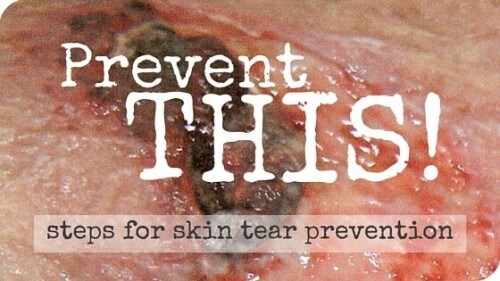Skin tears are a common condition for the patients we care for, which is why it’s so important for clinicians to know who is at risk, and what can be done to minimize them.
Painful. Disfiguring. Traumatic. Skin tears are all of these things, plus they can lead to further complications and serious infections. Unfortunately, they also happen to be a very common condition for the patients we care for. In fact, an estimated 1.5 million skin tears occur each year – and that’s just among institutionalized adults.
In addition to causing pain and discomfort, skin tears can be difficult to treat, and are a direct reflection of the quality of care delivered at our facilities. This is why it is imperative for clinicians to know who is at risk for skin tears, and what we can do to prevent them from happening.
Who is at risk?
Although skin tears can occur among all ages, the youngest and oldest patients are at the highest risk. This is due to the structure of both immature and aging skin. In addition, those who are dependent on caregivers for daily activities are particularly vulnerable, since they are regularly positioned and transferred for such things as bathing and dressing. Others who are higher at risk include:
- Older adults who ambulate independently
- Those who are critically ill or have multiple risk factors
- People with a history of skin tears
- Anyone with impaired mobility
- Those with sensory or cognitive deficits
- Patients with visible changes in the skin such as edema, dry skin or purpura
- Patients on four or more regularly prescribed medications
- Patients on specific types of medications, including analgesics, antidepressants, anticoagulants, and steroids
- People who are agitated and combative – they are more likely to bump into objects
- Those with cardiac, pulmonary or vascular disorders
Skin tear prevention
The truth is that skin tears are not completely preventable. Since part of our job is to support our patients’ independence and improve their quality of life, at some point or another, skins tears will occur. The good news is that, as caregivers, there are things we can do to keep them at a minimum.
Improve patient environments
A patient’s environment can be modified in simple ways that can make a big difference when it comes to skin tear prevention. For instance, you can make sure there is adequate lighting in your patient’s room or living space. Seniors, for example, typically need more light in order to see clearly and avoid accidents. Next, pad furniture corners and other objects that may cause blunt force trauma when bumped, and remove throw rugs that may buckle or slip. In addition, ensure that the patient is not wearing rings or other jewelry that can snag the skin.
Care for skin properly
Proper skin care can can go a long way in preventing tears. Skin is better able to resist tearing when it’s well-nourished and hydrated, which means nutrition plays a key role. Therefore, consult with a dietitian about the patient’s diet, and make sure they are receiving adequate fluids.
Frequent baths can dry out the skin, which increases the likelihood of skin tears. This can be a problem when facility regulations mandate that patients must have daily or weekly full baths. If you find that frequent bathing is contributing to dry skin, adjust the full-bath schedule to twice a week, with spot baths in between. Also, it’s important that when administering a bath, you:
- Use lukewarm water (not hot)
- Use soapless, pH-balanced solutions with no rinse or emollient soap
- Pat the skin dry – do not rub
To keep the skin hydrated following a bath, apply a moisturizing agent. The stratum corneum – or outermost layer of the skin – needs at least 10% moisture. Moisturizers should be applied while the skin is still damp (not completely dry and not soaking wet) to trap that moisture.
There are three types of moisturizers:
- Humectants promote the retention of moisture, replacing the oils in the skin
- Occlusives provide a layer of oil on the skin surface, slowing water loss
- Emollients soften and spread easily on the skin.
A humectant will pull the moisture up from the dermis into the epidermis to help keep skin intact (it’ll even pull moisture out of the air in the room). But humectants need to be coupled with an occlusive product to trap the moisture. In other words, you need to add a layer of oil on the skin’s surface to slow down evaporation.
Meanwhile, we want our skin to be able to slide, right? And that’s the role of emollients. They make the stratum corneum smooth and less susceptible to friction, which can create that skin tear.
More strategies for prevention are to cover fragile skin with long sleeves, pants and knee-high socks, or products such as DermaSaver® or Posey® SkinSleeves™. If something rubs up against the patient, the clothing or the device will move and hopefully not tear the epidermis from the dermis.
Be gentle, learn more
It goes without saying that we should be extra gentle when lifting, repositioning or transferring patients. By taking your time and softening your touch when caring for those at higher risk of skin tears, the frequency of such occurrences can be decreased.
Educating ourselves and our patients is also an important part of preventing skin tears. We need to understand the risk factors, keep the skin as nourished and moisturized as possible, avoid dangerous edges and surfaces in the environment, and treat patients gently.
For even more details on the prevention, staging and treatment of skin tears, view this free one-hour webinar recorded at the 2015 Wild On Wounds (WOW) National Conference. For access, click here and use the code SKINTEARS.
What do you think?
Were you already aware of who is most at risk for skin tears, and does this affect how you treat patients? And are there any preventative measures you regularly put in place that seem to help? If you have additional ideas, or any stories to share, please leave them below!
Wound Care Education Institute® provides online and onsite courses in the fields of Skin, Wound, Diabetic and Ostomy Management. Health care professionals who meet the eligibility requirements may sit for the prestigious WCC®, DWC® and OMS national board certification examinations through the National Alliance of Wound Care and Ostomy® (NAWCO®). For more information see wcei.net.
What do you think?

